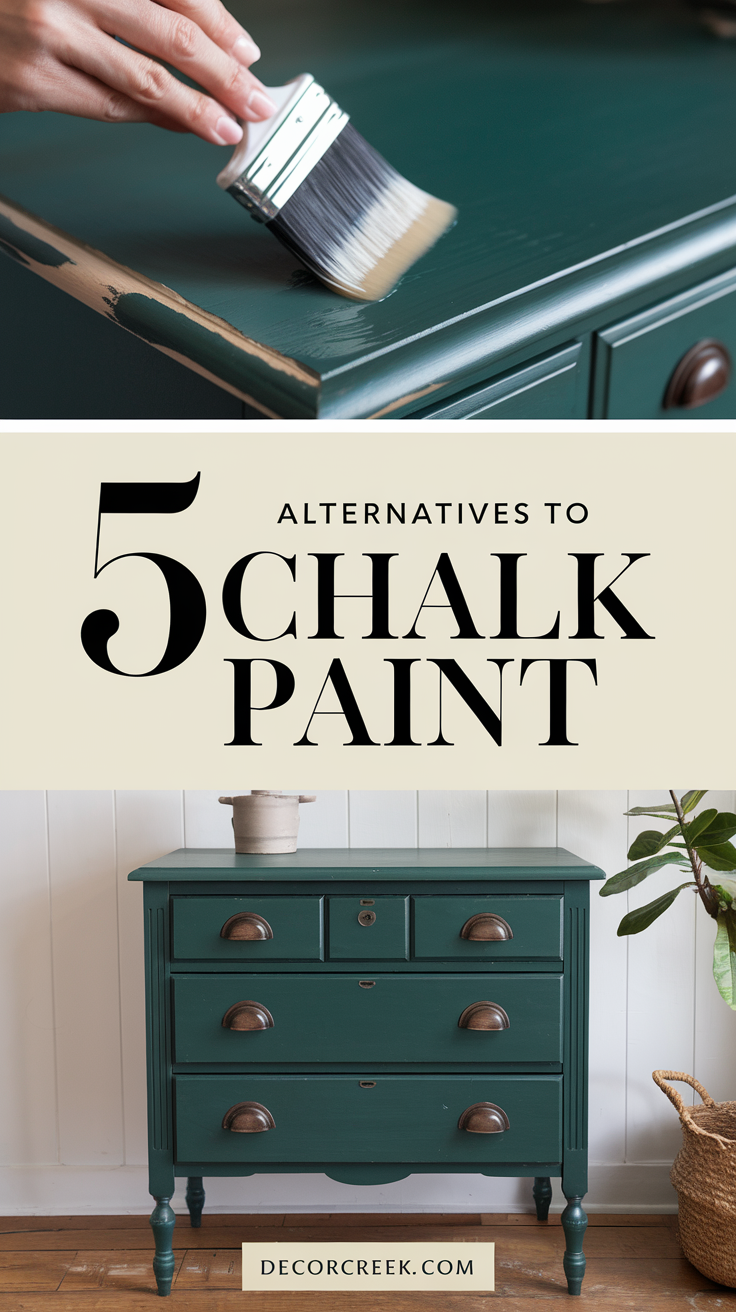When it comes to giving furniture or home decor a fresh look, chalk paint has been a popular choice for its matte finish and easy application.
However, chalk paint isn’t always the best option, especially for those looking for more durability, a wider range of finishes, or simply a different aesthetic. In this article, we’ll explore some better alternatives to chalk paint, including detailed recommendations on paints, brushes, and techniques to achieve the look you desire.
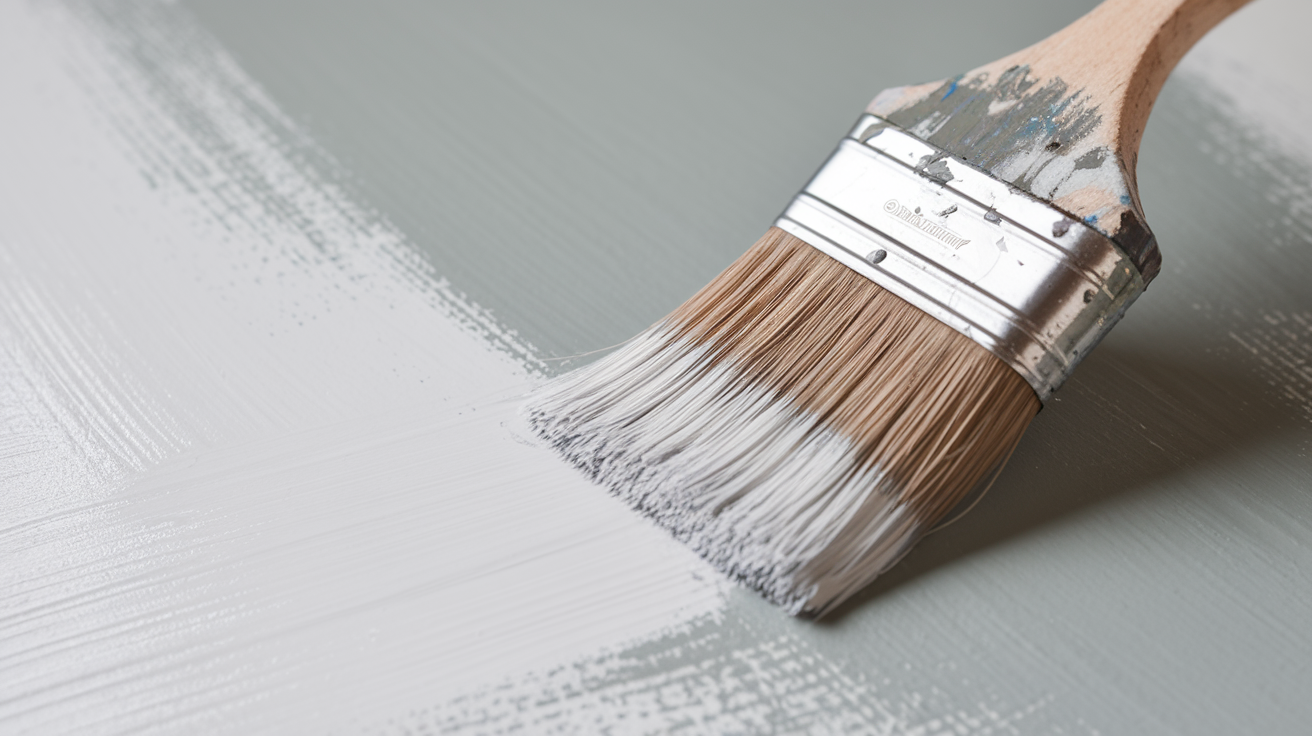
1. Acrylic Paint
Why It’s a Great Alternative:
Acrylic paint is versatile and durable, making it an excellent alternative to chalk paint. It adheres well to most surfaces, including wood, metal, and plastic, and is available in a wide range of colors and finishes, from matte to high gloss.
Best Uses:
- Furniture: Acrylic paint works well on furniture, providing a durable finish that can withstand daily use.
- Home Decor: It’s also ideal for smaller projects like picture frames or decorative items.
Recommended Brands:
- Behr Premium Plus Ultra: Known for its excellent coverage and durability, this brand offers a variety of finishes, including satin and semi-gloss.
- FolkArt Acrylic Paint: This is a great option for smaller projects and is available in a wide range of colors.
Brushes and Tools:
- Purdy Clearcut Series: These brushes are excellent for cutting in and getting sharp lines.
- Foam Rollers: Use foam rollers for large, flat surfaces to achieve a smooth finish.
Techniques:
- Sanding: Lightly sand between coats to ensure a smooth, even finish.
- Priming: Depending on the surface, applying a primer can help the paint adhere better and last longer.
In Brief: Chalk Paint vs. Acrylic Paint
Chalk paint is known for its matte finish and ability to adhere to surfaces without much prep work, making it a popular choice for those looking to achieve a vintage or shabby-chic look. However, its durability is often lacking, especially in high-traffic areas or on surfaces that need frequent cleaning. Acrylic paint, on the other hand, offers a much wider range of finishes, from matte to high gloss, and provides greater durability, making it a more practical choice for many projects.
While chalk paint can be easily distressed for a weathered look, acrylic paint offers more versatility in terms of application and finish. It’s easier to clean, resists chipping better, and is more suited for projects that require a durable, long-lasting finish. Additionally, acrylic paint is more forgiving in terms of brush strokes and application, allowing for a smoother and more even appearance, which is often desired in modern decor styles.
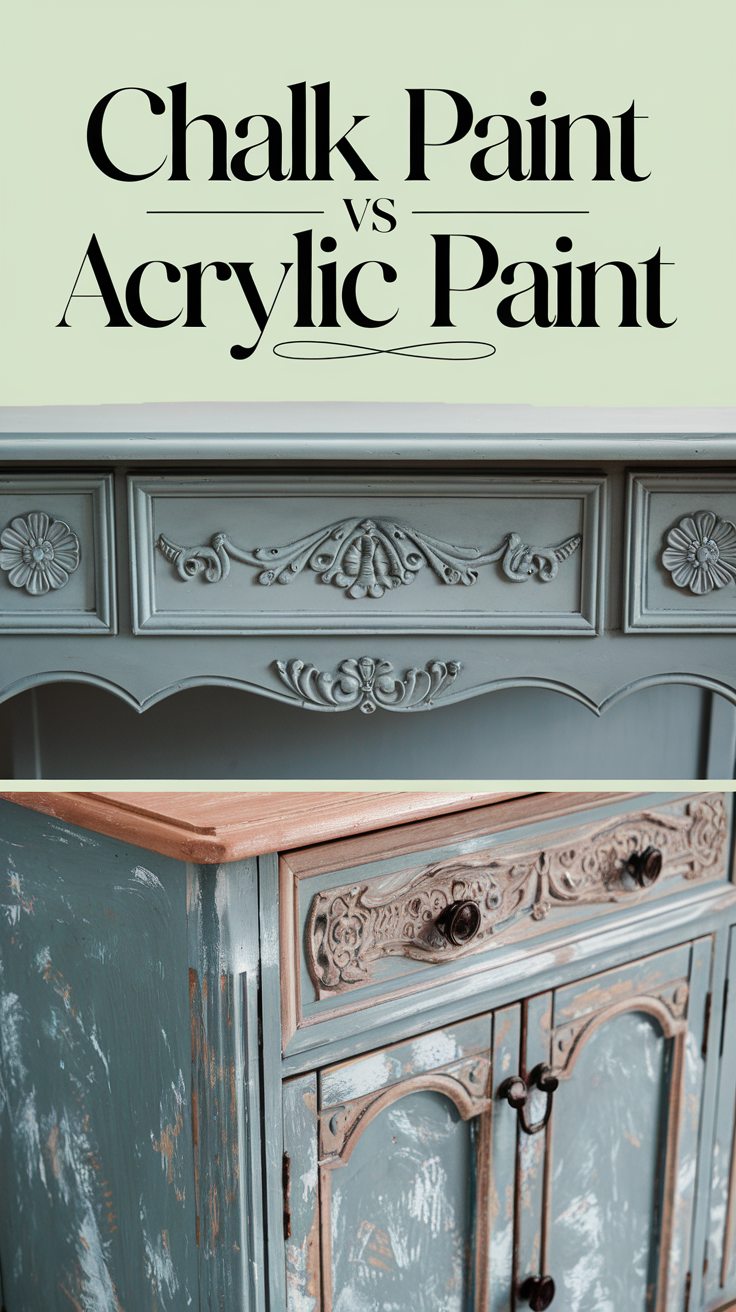
2. Milk Paint
Why It’s a Great Alternative:
Milk paint is a natural, eco-friendly option that provides a rustic, antique finish. It’s perfect for achieving a vintage or farmhouse look, similar to chalk paint but with a more authentic aged appearance.
Best Uses:
- Antique Furniture: Milk paint is ideal for restoring or recreating an antique look.
- Cabinets: It works well on cabinets, especially if you’re going for a distressed, country style.
Recommended Brands:
- Miss Mustard Seed’s Milk Paint: This brand is highly regarded for its authentic look and ease of use.
- General Finishes Milk Paint: A modern version of milk paint that doesn’t require mixing and offers excellent durability.
Brushes and Tools:
- Zibra Triangle Brush: This brush is perfect for detailed work and getting into corners.
- Natural Bristle Brushes: For a more textured finish, use natural bristle brushes.
Techniques:
- Distressing: Milk paint naturally chips and distresses, making it easy to create a weathered look.
- Mixing: Some milk paints come in powder form and require mixing with water, which allows you to control the thickness and opacity of the paint.
In Brief: Chalk Paint vs. Milk Paint
Both chalk paint and milk paint are favored for their ability to create a vintage or distressed finish. Chalk paint is known for its ease of use, requiring minimal prep work and often no primer, making it a go-to for DIY enthusiasts. However, milk paint offers a more natural, authentically aged appearance, which is especially appealing for those looking to achieve a true antique look. Additionally, milk paint is eco-friendly, made from natural ingredients, which can be a deciding factor for environmentally conscious consumers.
One key difference is that milk paint, unlike chalk paint, naturally chips and distresses over time, creating an authentically worn appearance. This can be an advantage if you’re aiming for a rustic or farmhouse style. In contrast, chalk paint requires sanding or additional techniques to achieve a similar distressed look. Milk paint also offers a more varied finish, from a solid, opaque coverage to a washed, translucent effect, depending on how it’s mixed and applied, providing more flexibility in achieving your desired look.
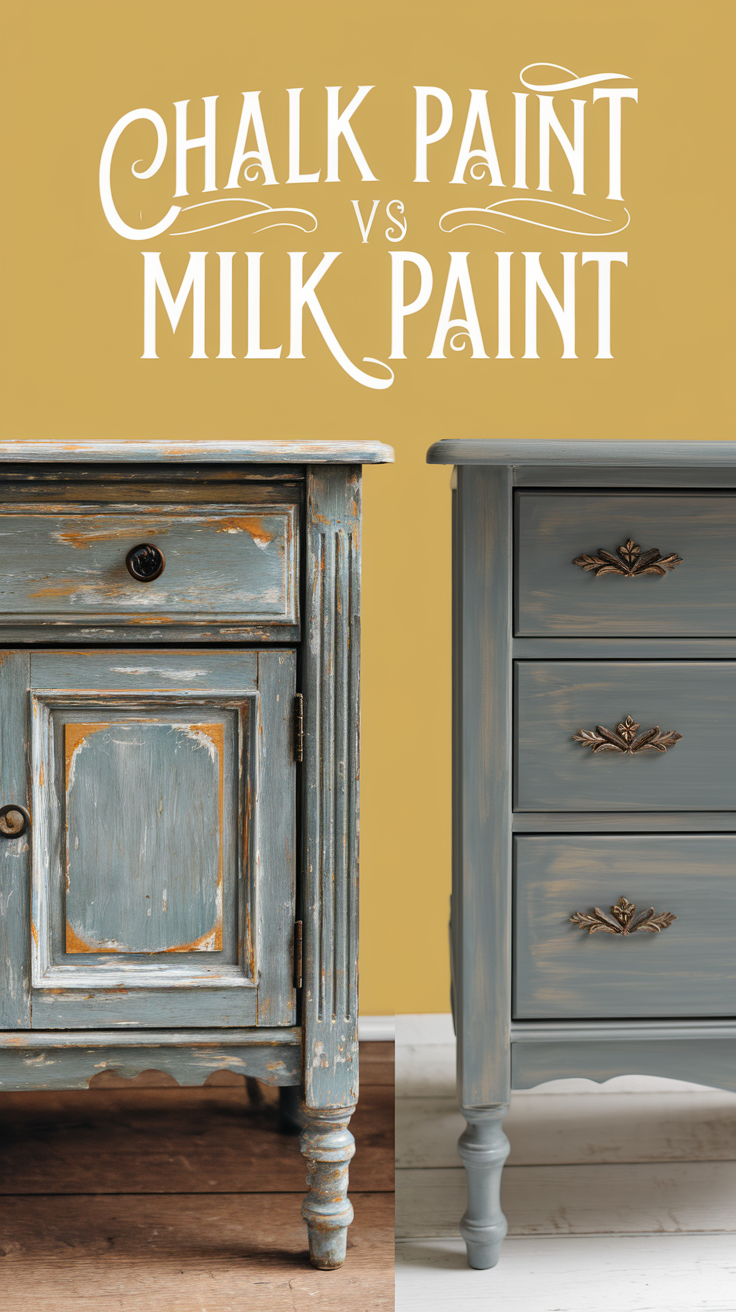
3.Regular Paint
Why It’s a Great Alternative:
Regular paint, often referred to as latex or acrylic latex paint, is one of the most commonly used paints for interior and exterior applications. It offers excellent durability, a wide range of finishes (from flat to high gloss), and is easy to apply with a brush, roller, or sprayer. Regular paint is also water-based, making it easier to clean up and more environmentally friendly compared to oil-based paints.
Best Uses:
- Walls and Ceilings: Regular paint is perfect for large surface areas like walls and ceilings, providing a smooth, even finish.
- Trim and Doors: It works well on trim, doors, and moldings, offering a durable, easy-to-clean surface.
Recommended Brands:
- Sherwin Williams Duration Home: Known for its durability and ease of application, this paint is ideal for high-traffic areas.
- Benjamin Moore Aura: Offers excellent coverage and a wide range of color options, making it a top choice for both interior and exterior projects.
Brushes and Tools:
- Purdy XL Series: These brushes are great for applying regular paint, providing smooth, even coverage without brush marks.
- Wooster Pro Roller Covers: Use these rollers for large areas to achieve a consistent, professional finish.
Techniques:
- Two-Coat Application: For best results, apply two coats, allowing each coat to dry thoroughly between applications.
- Primer: Depending on the surface, you may need to apply a primer before painting to ensure proper adhesion and coverage.
In Brief: Chalk Paint vs. Regular Paint
Chalk paint is often selected for its matte finish and ease of use, particularly for furniture and small DIY projects. It’s well-suited for achieving a vintage or distressed look but lacks the durability required for high-traffic or high-moisture areas. Regular paint, on the other hand, provides superior durability and a wide range of finishes, making it more versatile for various applications, from walls and ceilings to trim and doors.
While chalk paint requires minimal prep work and can be applied to most surfaces without priming, regular paint typically requires more surface preparation, such as priming and sanding, to achieve a smooth, long-lasting finish. Additionally, regular paint offers more options in terms of sheen and color, allowing for greater customization in both interior and exterior projects. If you’re looking for a paint that can withstand the rigors of daily use and provide a professional-grade finish, regular paint is a better choice.
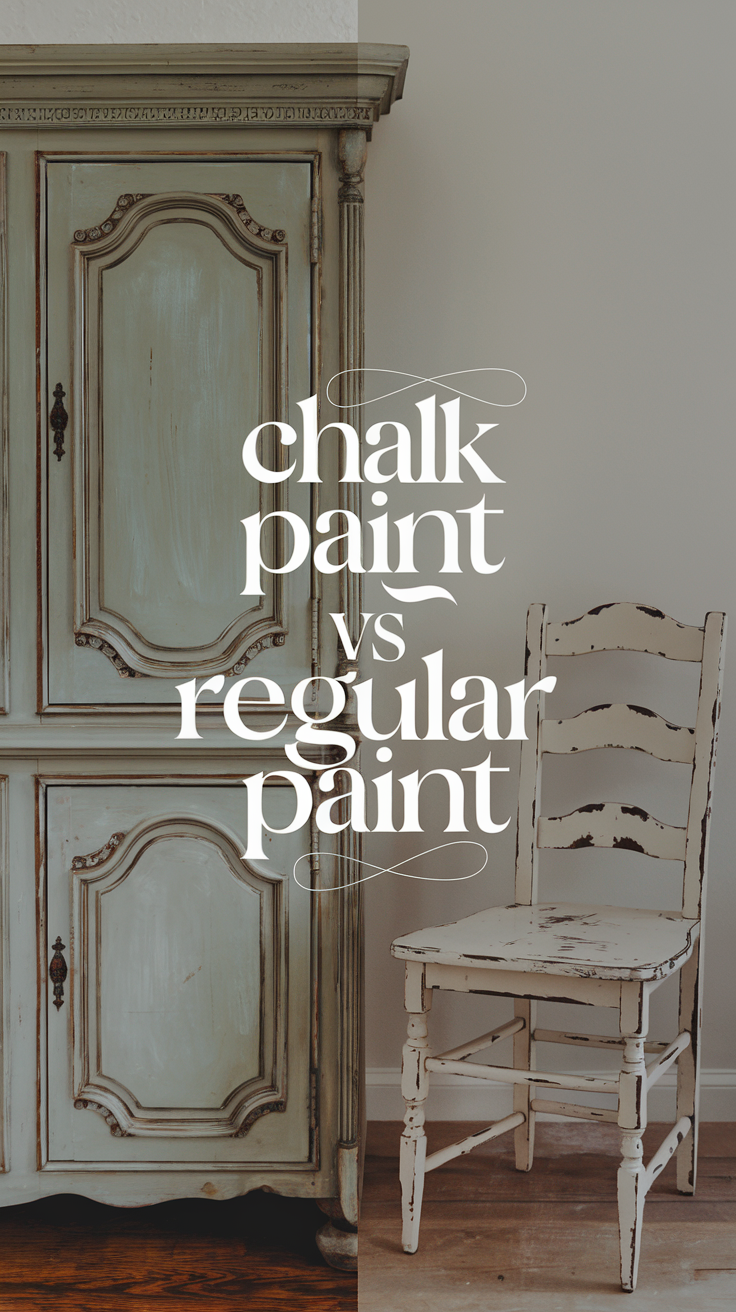
3. Latex Paint
Why It’s a Great Alternative:
Latex paint is highly durable and easy to clean, making it a fantastic option for high-traffic areas or surfaces that need frequent cleaning. It’s available in various finishes, from flat to glossy, and can be used indoors and outdoors.
Best Uses:
- Kitchen Cabinets: Latex paint is perfect for cabinets because it’s easy to clean and resists moisture.
- Walls and Trim: It’s also great for walls and trim, providing a smooth, washable surface.
Recommended Brands:
- Benjamin Moore Regal Select: This paint is known for its smooth application and long-lasting finish.
- Sherwin Williams SuperPaint: Offers excellent coverage and durability, ideal for both interior and exterior surfaces.
Brushes and Tools:
- Wooster Silver Tip Brush: A high-quality brush that provides a smooth finish without brush marks.
- Microfiber Rollers: These rollers are great for achieving a smooth, even finish on large surfaces.
Techniques:
- Two-Coat Application: For the best results, apply two coats, allowing the first coat to dry completely before applying the second.
- Sealing: Consider sealing with a polyurethane finish for added durability, especially on surfaces like kitchen cabinets or bathroom vanities.
In Brief: Chalk Paint vs. Latex Paint
Chalk paint’s appeal lies in its matte, velvety finish and its ability to adhere to surfaces without the need for extensive prep work. However, it’s not the most durable option, particularly in areas that see a lot of wear and tear. Latex paint, on the other hand, offers superior durability and ease of maintenance. It is highly resistant to moisture and can withstand frequent cleaning, making it a better option for high-traffic areas like kitchens and bathrooms.
While chalk paint is often chosen for its unique, textured finish and ability to create a distressed look, latex paint provides a smoother, more polished appearance. It’s also available in a wider range of sheens, from flat to high gloss, allowing for more customization based on the desired finish. Additionally, latex paint dries faster and is less prone to showing brush marks, which can be a concern with chalk paint, especially for beginners.
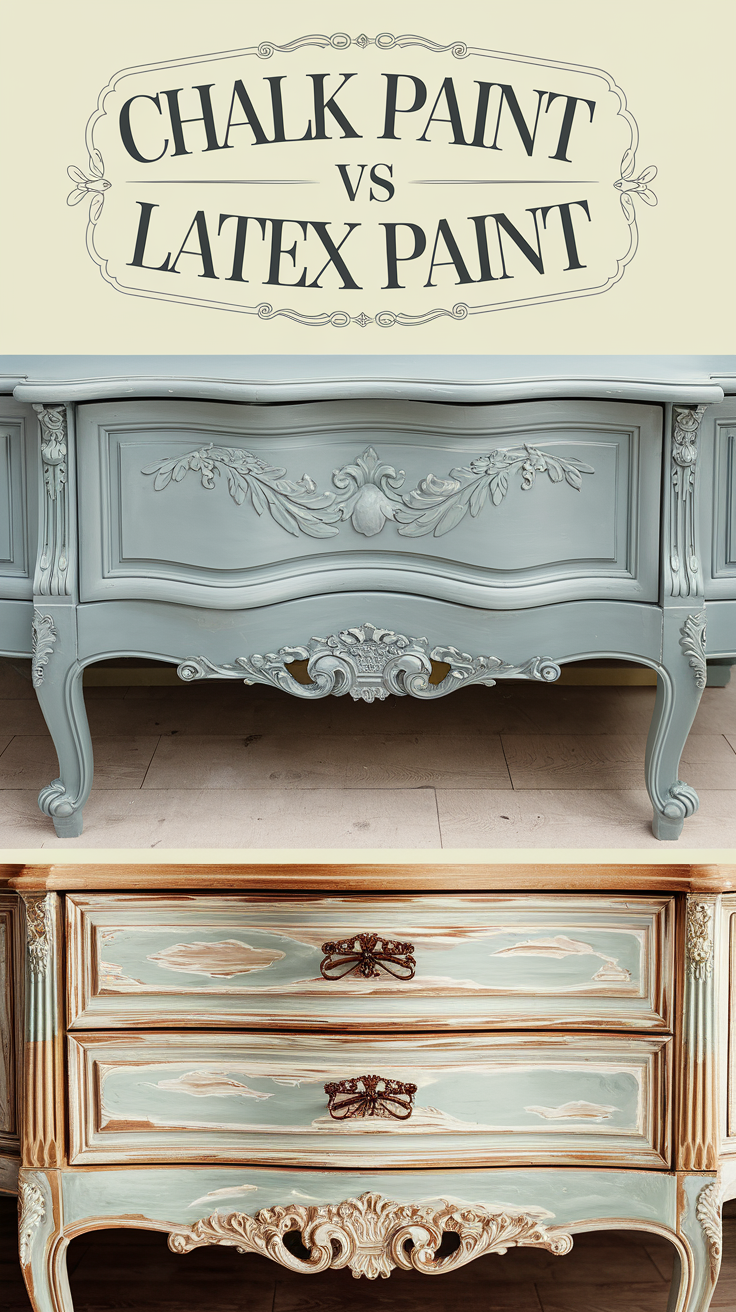
4. Enamel Paint
Why It’s a Great Alternative:
Enamel paint offers a hard, glossy finish that is highly resistant to scratches and stains. It’s a fantastic choice for surfaces that will see heavy use or need to stand up to the elements.
Best Uses:
- Doors and Trim: Enamel paint is perfect for doors, trim, and other surfaces that need to be both attractive and durable.
- Furniture: It’s also great for furniture that will be used frequently, like dining tables or chairs.
Recommended Brands:
- Rust-Oleum Stops Rust Enamel: This enamel paint is known for its durability and resistance to weathering.
- Krylon ColorMaster Paint + Primer: An excellent spray enamel option that provides a smooth, durable finish.
Brushes and Tools:
- Angle Brushes: Use angle brushes for detailed work and cutting in around edges.
- HVLP Spray Gun: For a professional-looking finish, consider using a High Volume Low Pressure (HVLP) spray gun.
Techniques:
- Thin Coats: Apply thin coats of enamel paint to avoid drips and achieve a smooth finish.
- Sanding Between Coats: Lightly sand between coats for the smoothest possible finish.
In Brief: Chalk Paint vs. Enamel Paint
Chalk paint is often chosen for its ease of use and its ability to create a vintage, matte finish with minimal prep work. However, it falls short in terms of durability, especially on surfaces that are subjected to heavy use. Enamel paint, in contrast, offers a much harder, more durable finish that is resistant to scratches, stains, and moisture. This makes it an ideal choice for high-traffic areas, doors, trim, and furniture that will be frequently used.
While chalk paint can achieve a rustic, distressed look with ease, enamel paint provides a smooth, glossy finish that is more suited to modern or contemporary styles. Enamel paint also tends to be more resistant to wear and tear, making it a better choice for items that need to stand up to daily use. Additionally, enamel paint’s glossy finish can give surfaces a polished, professional appearance that is difficult to achieve with chalk paint.
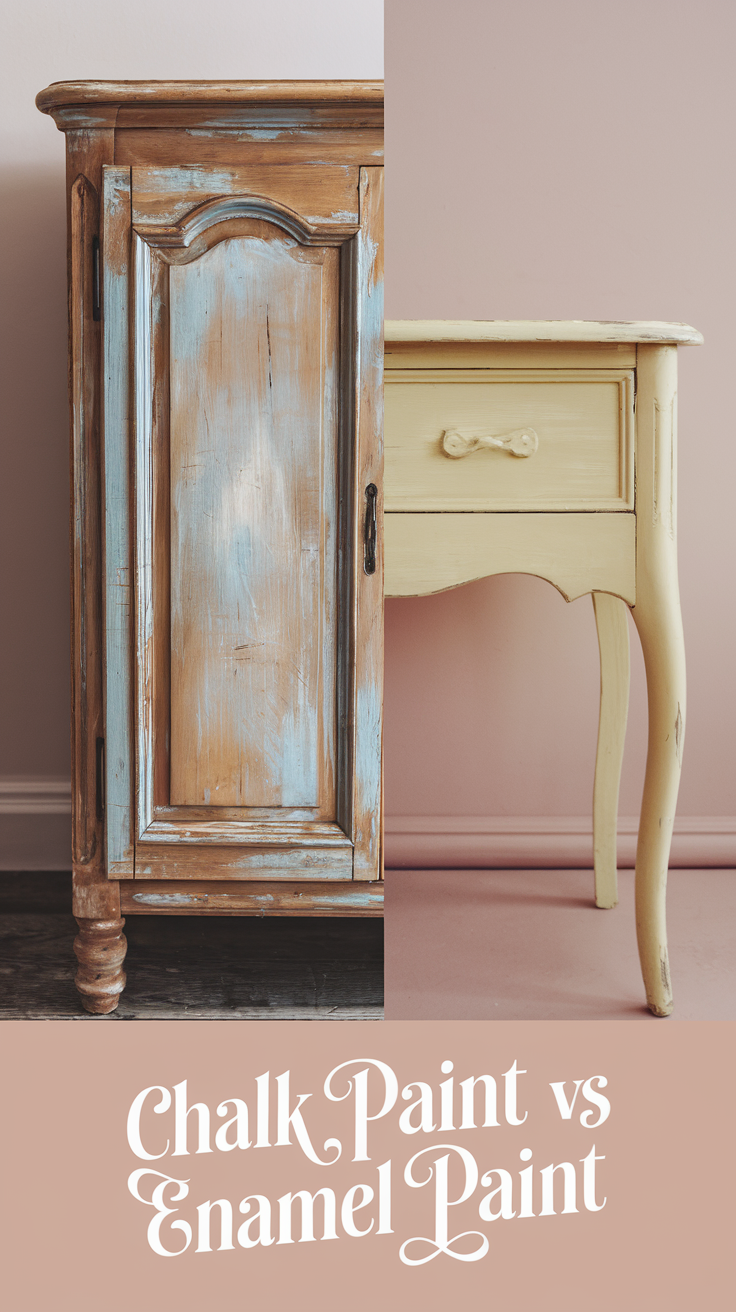
5. Mineral Paint
Why It’s a Great Alternative:
Mineral paint is a durable, self-sealing paint that adheres well to almost any surface without the need for a primer. It offers a flat, matte finish similar to chalk paint but with added durability and no need for a topcoat.
Best Uses:
- Furniture: Mineral paint is perfect for furniture, providing a long-lasting finish with minimal effort.
- Outdoor Projects: Because it’s self-sealing, it’s also great for outdoor furniture and decor.
Recommended Brands:
- Fusion Mineral Paint: One of the most popular brands, known for its ease of use and wide range of colors.
- Dixie Belle Paint Company: Offers a variety of mineral paints with excellent coverage and durability.
Brushes and Tools:
- Staalmeester Brushes: These brushes are designed specifically for use with mineral paint and provide a smooth, flawless finish.
- Foam Brushes: For smaller projects, foam brushes are a great option for achieving a smooth application.
Techniques:
- One-Coat Coverage: Mineral paint often provides excellent coverage with just one coat, making it a time-saving option.
- No Topcoat Needed: Unlike chalk paint, mineral paint doesn’t require a topcoat, making it a more convenient choice for many projects.
In Brief: Chalk Paint vs. Mineral Paint
Chalk paint is loved for its matte finish and ease of application, often requiring little to no surface preparation. However, it usually needs a topcoat or wax to protect the finish, which adds extra steps to the project. Mineral paint, on the other hand, offers a similar flat, matte finish but with the added benefit of being self-sealing. This means you can skip the topcoat, making it a more efficient and durable choice for projects that need to withstand wear and tear.
In comparison to chalk paint, mineral paint also offers better adhesion and durability, making it suitable for a wider range of surfaces, including outdoor projects. While chalk paint is excellent for achieving a vintage or distressed look, mineral paint provides a similar aesthetic with greater longevity and less maintenance. Additionally, mineral paint’s self-sealing properties make it more resilient to moisture and stains, which is particularly beneficial for high-traffic areas or items that will be exposed to the elements.

Conclusion
While chalk paint has its merits, these alternatives offer greater durability, versatility, and a wider range of finishes. Whether you’re looking for a matte, glossy, or distressed finish, there’s a paint that can meet your needs and exceed your expectations. By choosing the right paint and tools for your project, you can achieve beautiful, long-lasting results that go beyond what chalk paint can offer.
👇Save the Guide For Later👇
